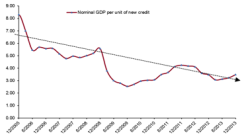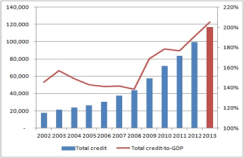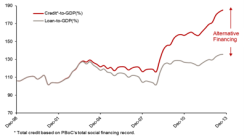“Capitalism without bankruptcy is like Christianity without hell,” quipped former Eastern Air Lines CEO Frank Borman, whose carrier would later face economic damnation. To be sure, Dante Alighieri reserved the Eighth Circle of his Inferno for financial fraudsters, suitably chastised by devils in Sandro Botticelli’s oil painting Inferno, Canto XVIII, which I noticed at Berlin’s Gemäldegalerie when I was in Germany reporting on euro zone monetary politics for Institutional Investor last fall.

What kind of insolvency inferno lurks within Red Capitalism, Carl Walter and Fraser Howie’s pungent exposé of China’s Communist Party–controlled financial system, which I reread on the 15-hour flight from New York? The Buddhist tableaux that I saw in Beijing’s Yonghe Lamasery have some colorfully grim images of demons at work in the Tibetan afterlife, but bankrupts don’t get singled out for special treatment, at least as far as I could tell.

Buddhist images of any kind are scarce at the imposing headquarters of the People’s Bank of China (PBOC), at the diagonally opposite corner of Beijing’s Second Ring Road, where Governor Zhou Xiaochuan and his team of technocrats are engaged in “China’s riskiest and most important credit experiment in recent history,” as one Shanghai banker described it to me.
“The leaders on the Standing Committee of the Politburo are backing the reformers at the PBOC to let the market set interest rates, so that these rates reflect the credit risk of the borrowers,” explained the banker, who was reluctant (as are many China sources right now) to go on the record. The team of former president Hu Jintao “gave lip service to this goal but didn’t back the PBOC when push came to shove. This time I think they’re serious at the top,” he added.
State Council Premier Li Keqiang made multiple “marketizing” references in his “Work Report” to the 12th National People’s Congress in Beijing on March 5. “We will continue to liberalize interest rates by granting financial institutions more power to set their interest rates,” he intoned before the 2,986 delegates in the Great Hall of the People, echoing the promises made at the Third Plenum of the 18th Communist Party Congress in November last year.
Li’s stated goal is to marketize the allocation of credit from savers to the actual users of credit. Since the founding of the People’s Republic in 1949, the savings of individual Chinese have been vacuumed up by state-controlled banks and then lent to largely state-owned enterprises (SOEs). In the past few years the PBOC has been slowly relaxing its grip over both deposit and lending rates. Last July the cap on the lending rate was eliminated; deposit rates are becoming more flexible as well.
But credit risk has not been fully priced into loans or, for that matter, into the deposit rates on different savings vehicles, because SOEs theoretically have no credit risk. According to Premier Li, this is about to change. Or is it?
One view, the prevailing opinion among the experts in China I spoke with earlier this month, says that it is indeed possible to gradually dismantle China’s long-standing system of financial repression and organically grow a new risk-priced market for credit in parallel with the existing state bank– and SOE-allocated credit structure. A Hong Kong–based private equity CEO described this as the “one system, two markets” view, a wry reference to Hong Kong’s status as a Special Administrative Region, whose largely independent coexistence as part of China is known as “one country, two systems.”
An opposing view, more prevalent in New York and London, says, in effect, “You can’t get there from here,” and anxiously awaits a credit train wreck in China. “China’s financial system is still insulated from external pressures; it’s a domestic problem. But it’s too complicated to run two huge domestic credit markets in parallel, no matter how clever the policymakers and how interventionist,” warns a Shanghai-based economist. “The leakage and indirect connections between the market systems and the allocated credit systems are getting more baroque every day. The demand for capital by firms is insatiable, at any price.”
Kyle Bass, the Hayman Capital founder and principal renowned for taking big macro bets on Asian markets, largely agrees. “I believe it to be naive at best for anyone to believe that it is possible to fully control a $25 trillion banking system with $9 trillion of GDP. This credit experiment in China has reached such a large gross critical mass that it is literally impossible to control, regardless of desire, incentive or perceived ability to do so,” he says. “How can anyone grow banking assets at 150 percent of GDP over a four-year period and hold NPLs [nonperforming loans] at 1 percent? Only if you are the person in charge of reporting the numbers, is my answer.
“NPLs will increase, and the changing value of collateral for the loans won’t be able to be stopped, in my opinion,” he predicts. “Even with the best intentions, the PBOC and powers that be won’t be able to slow down the credit bust.”
Although many bankers and naysaying critics in the West are transfixed by the prospect of a string of credit defaults in China, the more confident observers in Beijing and Shanghai claim this is the next phase of an evolutionary financial sector strategy that has been under way, step by step, since the reforms kicked off by former paramount leader Deng Xiaoping in 1978.
According to Yiping Huang, an economics professor at Peking University and chief economist for emerging Asia at Barclays Capital, there are four pillars of this strategy: building financial industry frameworks, such as the central bank and stock exchanges; increasing the number and size of commercial banks and listed firms; altering the governance and behavior of financial institutions; and liberalizing financial markets themselves, including the introduction of competitive rate-setting. “The government has been more decisive on 1 and 2 but more conservative on 3 and 4,” says Huang.
What set of motives would make the government — in this case the all-powerful seven members of the Standing Committee of the Politburo of the Communist Party of China, led by Li and President Xi Jinping — more decisive in marketizing credit?
They have three interrelated motives: rebalancing China’s macro economy away from financial repression, sustaining real economic growth and avoiding a meltdown of the shadow banking system.
“The financial repression model creates a tangle of side effects, which if not eventually pruned back can severely impede economic growth,” explains Arthur Kroeber, senior fellow at the Brookings-Tsinghua Center in Beijing and editor of the China Economic Quarterly. “Households earn a lot less income from their bank deposits than they would if interest rates were set by the market, so household incomes tend to grow slower than GDP. Second, because the return on their savings is minimal, households need to save a larger share of their annual income in order to meet their long-run savings goals for retirement and medical expenses. Finally and most subtly, cheap capital creates incentives for investing in capital-intensive manufacturing rather than labor-intensive services.” In short, financial repression must be rolled back to rebalance away from fixed investment’s towering 50 percent share of the economy.
“Remember that we have financial repression in the U.S. too,” cautions Frank Newman, the former CEO of Bankers Trust and deputy U.S. Treasury secretary who later ran the Shenzhen Development Bank, which provided him with a remarkable insider’s view. “The PBOC set interest rates low, and so did the Fed. SOEs got lots of cheap money, and so did General Electric, for that matter. The mechanism is different; the effect is the same. Lending rates to GE accurately reflect GE’s low credit risk. Lending rates in China are just starting to reflect risk, at least to some degree, although imperfectly. SOEs’ cost of capital is still distorted by the PBOC put,” an implicit assumption that the central bank will intervene to prevent any credit bust.
In this sense, the PBOC put socializes credit risk rather than requiring investors to make a firm-by-firm judgment. “And it is a credible put,” explains William Overholt, president of the Fung Global Institute, a Hong Kong–based think tank. “China’s strong international investment position insulates it from the risk of a squeeze by foreign creditors. The overall debt levels of the Chinese government, on a consolidated basis, while much higher than even a few years ago, are still low compared with many countries in the West or with Japan, for that matter. So the credit system isn’t vulnerable to a credit run from the foreigners. Rather, it’s a matter of domestic creditors keeping faith in the system.”
The manager of a Connecticut-based hedge fund concurs. “With respect to the proportional size of the ‘credit bubble’ to the Chinese economy, I think there is agreement that, while credit growth in China has been extremely steep in the last five years, current credit metrics are not outside of the norms for advanced economies. China has between 175 and 200 percent of GDP in total credit, while in Europe the same metric is 430 percent of GDP,” he says. “The central authorities clearly have the resources to take the punch, and the domestic pool of savings which has provided the core capital for the credit expansion is captive within the system and has no recourse if subjected to haircuts or losses. Credit creation in China is internally, not externally, financed, and flight of domestic Chinese capital is simply not permitted. Credit-driven train wrecks generally occur in systems which are externally financed.”
Moody’s Investors Service agrees with Overholt and the hedge fund manager. “China’s Aa3 rating is supported by a high degree of economic resiliency and very high financial robustness, as is reflected in an exceptionally large and positive net international investment position of more than 20 percent of GDP and which is bolstered by almost $4 trillion in official international reserves,” the firm wrote in a February research note. “Capital controls insulate against external shocks and provide time for further advancement of financial system reform.”
The Politburo’s second motive for the transformation of the credit system is maintaining the high levels of real economic growth that are both the party’s greatest achievement and, increasingly, its best remaining source of legitimacy to govern as a one-party state. SOE reform is a critical policy instrument.
According to Overholt, “The members of the Standing Committee may not know macroeconomics that well, but they certainly understand statistics, and the numbers that they’ve been viewing quarter by quarter show that the amount of capital required to keep the economy ticking is going up and up, even as the growth rate has been slowing.”
In other words, the capital intensity of the Chinese economy has been increasing and the marginal return on capital decreasing. The amount of GDP growth engendered by new credit has fallen, from 8 to 1 in 2005 to 6 to 1 in 2008, and has been bouncing around between 3 and 4 to 1 since the financial crisis. A linear regression suggests the growth ratio has been falling by a full point roughly every 24 months, and it is headed in just one direction — down.

At some point basic math brings the growth trajectory back to earth, just as happened in the other capital-intensive Asian growth stories in Japan and South Korea. “We’ve seen this movie before,” says Overholt, who worked at Nomura Securities in Asia before he headed up the Rand Corp.’s research operations in Santa Monica, California.
It’s not just capital intensity; the more economically literate among the Chinese leadership, as well as the extremely literate technocrats who labor below the Politburo in the People’s Bank of China, the Ministry of Finance and the National Development and Reform Commission, all realize that the efficient allocation of capital is the only way to ensure sustained productivity growth in the Chinese economy.
Economic growth comes from just three things: growth of capital stock, growth of the labor force and so-called total factor productivity. The Politburo knows that the capital stock trajectory must slow and that China’s labor force has already started to flatten and could begin to shrink as early as 2020. That leaves total factor productivity as the sole remaining driver of growth. Given that most state-owned enterprises are notoriously unproductive in their use of capital, sustained productivity growth can only come from enterprises that respond to market signals and allocate credit efficiently — either thoroughly reformed SOEs or the private sector.
Brookings-Tsinghua’s Kroeber cites the predictions of Liu Shijin and Zhang Junkuo, leading economists at the State Council’s Development Research Center (DRC): “With the adoption of market and financial reforms, China can sustain real GDP growth of at least 7 percent for another decade, but without such reforms growth could fall to as low as 4 percent in a few years’ time.” This is about as authoritative a conclusion as you can get by the Politburo’s own think tank.
“As long as the growth rate remains at 7 percent or above, the Politburo has no rush to make any drastic changes in China’s financial system,” says Andy Liu Qiang, China analyst at Teneo Intelligence, a New York–based political risk consultancy that I head. “The real bottom line for them is 7 percent, so any policy changes will be gradual. The Politburo knows it still has time before China’s credit market must be liberalized completely, and in fact the PBOC’s Zhou, speaking on the sidelines of the National People’s Congress in March, said interest rate marketization can be achieved within two years.”
The Politburo’s third motive for introducing risk-based credit is the ticking time bomb of the shadow banking system that has grown alongside the state-controlled banking system over the past few years. Total credit has exploded from 140 percent of GDP in 2008 to 200 percent in 2013. This mountain of debt is riddled with doubtful loans, shaky borrowers and what one Beijing-based foreign banker described to me as “a gigantic sinkhole of moral hazard.”

More ominously, “alternative financing” (the shadow banking system) has accounted for the lion’s share of that credit growth. And much of the shadow banking system is funded by so-called wealth management products, or WMPs.

Source: Credit Suisse
According to the China Banking Regulatory Commission (CBRC), $1.6 trillion was invested in WMPs at the end of September 2013. No one knows exactly how much bigger that figure has grown since — which is part of the problem. The total should be around $2 trillion now, of which about a third — again, no one knows for sure — will mature this year and have to be rolled over.
Therein lies the heart of the problem: a massive maturity mismatch. WMPs are short-term instruments funding long-term assets, many of dubious quality. A typical transaction involves a “credit trust” vehicle that has a claim on the assets of a borrower, units of which are sold by big banks to individual savers as wealth management products paying relatively high interest rates.
There were two relatively small credit trust defaults in 2012, one distributed by Huaxia Bank and another by CITIC Trust, and a handful of trust defaults in early 2013. The most colorful problem concerned Credit Equals Gold No. 1, a wealth management product issued on behalf of a mining company Shanxi Zhengfu Energy Group and sold by Industrial and Commercial Bank of China. When the company couldn’t meet payments due on trust certificate in January, the authorities arranged a last-minute bailout, but investors took a haircut on their promised 10 percent interest rate.
Credit difficulties intensified in March when two companies — Shanghai Chaori Solar Energy Science & Technology Co. and Zhejiang Xingrun Real Estate Co. — defaulted on corporate bonds, the first such bond defaults in modern Chinese history.
Foreign critics of the “can’t get there from here” school believe these are just the beginnings of a snowball of defaults that will pick up over the summer and avalanche into the third calendar quarter. But believers in the “one system, two markets” school are confident these defaults will be few and far between and, most important, contained by the PBOC and the policy apparat.
In a somewhat wistful look back at the financial crisis, then Fed chairman Ben Bernanke put shadow banking at the top of his list of causes at a seminar organized by my Princeton colleague and former Fed vice chair Alan Blinder at New York’s Princeton Club in April 2012. “In retrospect, it is clear that the statutory framework of financial regulation in place before the crisis contained serious gaps,” Bernanke recalled. “Much shadow banking lacked meaningful prudential regulation. No regulatory body restricted the leverage and liquidity policies of these entities, and few if any regulatory standards were imposed on the quality of their risk management or the prudence of their risk-taking.”
Politburo policymakers and their entourage of think tanks, such as the DRC and the Chinese Academy of Social Sciences (CASS), have studied the financial crisis and its policy response in the West with care. They paid almost as much attention to the collapse of Lehman Brothers Holdings as they did to the collapse of the Soviet Union. “We Chinese believe in the lessons of history,” an old friend of mine at CASS e-mailed me. “One of our big lessons of ’08 and ’09 was your fragmented regulators and political dilly-dallying in Washington,” he added, clearly agreeing with Bernanke.
Reflecting this cautionary insight, the State Council issued a remarkably detailed and preemptive directive late last year to plug China’s oversight gaps and begin to bring the shadow banking system under closer supervision. The Council sent a sensitive missive titled “Document 107” on December 11 to provincial and local authorities, setting out a new framework for regulating the shadow banking sector, “with detailed regulations and responsibilities, including the duties of relevant government organs, to follow.”
The document, which leaked to the public three weeks later, was drafted by the PBOC, the CBRC, the China Insurance Regulatory Commission and the China Securities Regulatory Commission and issued by the General Office of the State Council — Beijing speaking with one authoritative voice. As it says in its preamble, “The shadow banking system has become a diversified funding channel for the development of China’s social economy, but it has in the meantime presented the risks of poor supervision, regulatory arbitrage and ill-managed business practices spilling over into the traditional banking system.”
Working together, the regulatory agencies can plug the supervisory vacuum and regulatory arbitrage problems, but how do banks (or shadow banks) learn to price credit and avoid “ill-managed business practices”? A whole bundle of institutions — including accounting, auditing and credit analysis firms, not to mention credit reporting services, a pugnacious business press and procedures for clearly establishing ownership and title — has grown up in capitalist (as opposed to Red Capitalist) countries over decades in order to perform this crucial function. You can’t solve it with a State Council missive.
“It’s like the money market Field of Dreams,” the Shanghai banker quipped to me over a cup of green tea on the Bund. “Build demand, and the institutions will come. We Chinese are all pretty fast learners. Just look around you,” he said, gesturing at the Pudong financial district towering across the murky Huangpu River.
Everything I know about China suggests he is on the money about Chinese fast learners but overly optimistic about the Field of Dreams approach to credit. I’ve been working in Asia in various incarnations as a banker, business manager, academic and government official for four decades since 1973 and have watched both the Japanese and Korean growth models — and their ultimate credit debacles — up close. I spent most of 1974 in Chase Manhattan Bank’s credit training program, learning the minutiae of financial accounting, debt capacity, liquidity “quick ratios” and contingent liabilities. The type of institution required to make sound credit decisions has always struck me as extremely time-consuming to build, even in primarily free market societies.
As a personal aside, we trainees spent endless hours at Chase erasing and reworking balance sheets and P&Ls by hand. When inventor Daniel Bricklin demonstrated VisiCalc, the world’s first electronic spreadsheet program, to my class at Harvard Business School in 1979, I decided to skip Wall Street and head out to Silicon Valley instead.
I agree with Frank Borman’s “bankruptcy and hell” aphorism. No rational institution will go to all the time and trouble to correctly estimate risk unless it knows just how painful it is to get it wrong, and getting it wrong means taking the pain of write-offs. Life is so much easier if you have a Tokyo, Seoul or Beijing put to rely on.
In other words, some Chinese firms will have to go under to build these credit institutions, and the banks (or shadow banks) will have to suffer the consequences. Per the pungent Chinese proverb, You must kill some chickens to scare the monkeys. It’s actually punchier in Chinese, a simple four-character compound that translates to, literally, “Kill chicken scare monkey.”
Which chickens will be sacrificed? I’ll examine that dilemma for Chinese policymakers in the second part of this article.
James Shinn is lecturer at Princeton University’s School of Engineering and Applied Science (jshinn@princeton.edu) and CEO of Teneo Intelligence in New York City. After careers on Wall Street and Silicon Valley, he served as national intelligence officer for East Asia at the Central Intelligence Agency and as assistant secretary of defense for Asia at the Pentagon. He serves on the advisory boards of Kensho Technologies, a Cambridge, Massachusetts–based data analytics firm, and CQS, a London-based hedge fund.






